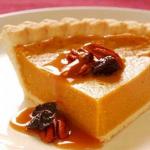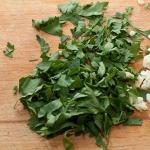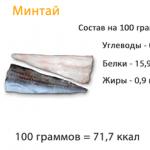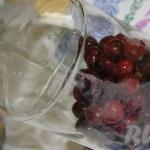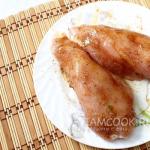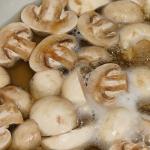Instructions for brewing Coopers beer. Instructions from Coopers wort in Russian Making beer from extract
Description
Coopers Dark Ale malt extract allows you to brew dark beer from the CLASSIC OLD DARK family. Made from the finest South Australian malts and barleys, giving the drink its full ruby flavour...
To prepare 23 l. beer approximately 4.5% alc. about. required:
Coopers 1.7kg can of concentrated wort.
1 kg dextrose (glucose) or 1.25 kg unhopped malt extract
1 sachet of brewing yeast (10 g)
Coopers jars already have the yeast under the lid.
Water.
Equipment
1. Capacity about 32 liters.
2. Water seal.
3. Silicone or food grade PVC tube for pouring, de-sludge of beer, and bottling.
4. PET containers or glass bottles for bottling 23 liters of finished beer.
5. Hydrometer for measuring and monitoring the fermentation process and determining the final density.
6. Thermometer for temperature control.
All equipment must be washed and disinfected. Rinse all equipment thoroughly after disinfection. Do not use homemade cleaners or compounds.
By diluting the kit to 18 liters instead of 23, the result will be a beer with a fuller, rounded aroma and an alcohol content of approximately 6%.
Note - when using unhopped wort or dry malt concentrate, they must be boiled for 10-15 minutes.
Fermentation
1. Pour 2 liters into a saucepan. water, heat, add dextrose (glucose), boil for 30 minutes. over low heat, add the concentrated wort, bring to a boil, leave to cool under the lid closed for a while (10-15 minutes).
2. Pour 15 liters into an empty sterile container. cold water, add the wort with syrup, bring to a volume of 23 liters with cold water. Stir.
The temperature of the wort before adding yeast should be 18 - 28 C.
3. Scatter the yeast over the surface of the beer and close the lid.
4. Leave the container in a warm place at a temperature of 18 - 24 C; the beer will ferment for approximately 4 to 8 days.
5. Before pouring the beer, you need to check whether fermentation has ended or not. Signs of the end of fermentation: no bubbles should rise to the surface, the beer becomes clear. Hydrometer readings should not exceed 2%.
6. It is advisable to additionally remove the beer from the sediment; to do this, you need to carefully pour the beer into a sterile container without lifting the yeast from the bottom, and leave it to settle for 24 hours, then remove it from the sediment again, before adding sugar for further fermentation. It is important to ensure that fermentation is completely complete before bottling the beer, otherwise there is a risk of bottle rupture.
After-fermentation. Beer maturation.
1. During the fermentation and maturation process, your beer will become saturated with carbon dioxide, which adds life and sparkle to the beer.
2. Prepare sugar syrup: for 100 g. water 170 gr. dextrose (glucose). Add the syrup to the skimmed beer. Do not exceed the amount of sugar, otherwise the beer will be too carbonated. Using a siphon tube, pour the beer from the container into the bottles without adding 5cm. to the edge of the bottle.
3. Tightly screw or crown cap your bottles, place in a warm place at approximately 20 C and leave for approximately 7 days for secondary fermentation. Store beer in a dark place.
4. Then move the bottles to a cool place to allow the beer to mature. Ripening will take approximately two weeks. Once the beer is completely clear, it is ready to drink, but the taste will improve if it is left to mature for a month.
5. When bottling beer, be careful not to disturb the yeast sediment that will collect at the bottom of the bottle. You may like to pour the beer into a pitcher first. Drink chilled.
The gravity of your beer and the alcohol content can be varied, keeping the base of one or another type of malt extract. Note that the quality of beer made from one can of extract is generally improved by reducing the amount of water or sugar. Excessive dilution with water or additional sugar to increase the alcohol percentage will disrupt the full body and balance of the beer.
Sugar for the production of alcohol can be added not only in its pure form, but also in the form of additional malt extract.
If you dare to incur additional costs, you can use the same beer extract in an amount of 1.25 kg instead of 1 kg of sugar. The results will be obvious - your beer will gain greater body, richer taste and aroma and will become a true gourmet drink. In addition to the complete replacement of sugar with an extract, any partial ones are allowed. Just remember the proportion of 1.25 kg of malt concentrate or 1 kg of sugar.
Create - and you will have your own, unique beer!
Making beer from extract
There are two main options for making beer at home - extract and grain.
In the grain version, you prepare your own beer wort using one or another type of malt, hops and yeast. The wort preparation process consists of mashing, boiling and hopping.
In extract brewing, all the work of preparing the wort is already done for you. This is a can that contains an already hopped beer wort extract, adjusted to a specific type of beer. For example, Wheat or Stout. This extract can only be diluted with water and fermented.
Instructions for brewing Coopers beer
Malt extracts (concentrate) are made from barley, wheat or rye malt. During the extraction process, the soluble components are separated from the husks and other solid impurities, then the resulting solution is concentrated to the consistency of a thick syrup, which is the malt extract.
This substance has excellent stability due to the minimal amount of water and high sugar content, which makes it possible to do without the use of preservatives.
You can make excellent beer from extracts using a home brewer.
All equipment must be washed and disinfected. Disinfection of equipment is carried out before each preparation of beer by boiling, using special means, soda or iodine. Rinse all equipment thoroughly after disinfection. Do not use homemade cleaners or compounds.
In these instructions, the word “sugar” means regular sugar, dextrose (glucose), and even honey. Whoever likes it. It is believed that dextrose (glucose) gives a purer taste to the drink, and after sugar, sometimes a yeasty taste can appear, which disappears during longer aging. An excellent option is to use the same wort as sugar, only unhopped.
Any sugar that you will use for carbonation is recommended to be added in the form of syrup boiled for 10-15 minutes and cooled.
You can buy water or use regular tap water. It is better to let tap water sit for a day, or pass it through filters, or boil it.
To prepare 23 l. beer approximately 4.5% alc. about. required:
1. 1.7 kg jar of Coopers extract with yeast under the lid.
2. Sugar 1 kg.
3. Capacity 32 l.
4. Water seal.
5. Silicone tube for bottling.
6. PET containers or glass bottles for bottling 23 liters of finished beer.
7. Hydrometer-sugar meter for measuring and monitoring the fermentation process and determining density.
8. Thermometer for monitoring fermentation temperature.
9. Mixer paddle
Fermentation
1. Place the jar with the extract in hot water for 10 minutes. This will soften the contents of the jar, and the extract will be easier to pour out.
2. Pour 2 liters into the pan. water, heat, add sugar, boil for 30 minutes. over low heat, add the extract from the jar, bring to a boil and leave to cool with the lid closed for 10-15 minutes.
Ideally, Brew Enhancer-1 or Brew Enhancer-2, which contain dextrose and maltodextrin, will improve the body and flavor of your homebrew as a replacement for sugar in the main fermentation.
3. Pour 15 liters into a disinfected container. cold water, add the wort with syrup from the pan and bring the volume to 23 liters with cold water. Stir.
The temperature of the wort before adding yeast should be 24 - 26C. It is usually indicated on the jar or bag of yeast.
4. Sprinkle the yeast evenly over the surface of the beer and close the lid.
According to the manufacturer's recommendation, you can rehydrate the yeast. Rehydration is the activation of dry yeast (watering).
For this you need any small container of about 300-500 ml. You can disinfect it with an aqueous solution of iodine for 5 minutes. Pour boiled water into it, bring the water temperature to 27° C (for lager yeast 23° C) and carefully pour the yeast into it. They will gradually sink to the bottom (15-30 minutes). Next, continue stirring slowly for another 30 minutes. Then inoculate the fermentation tank with the resulting yeast suspension.
Brewing beer from extract is very attractive to beginners, as it allows you to make real homemade beer without malt (grain) and special equipment (pots and a fermentation tank are enough). If all the rules are followed, the drink comes out better than most store-bought varieties.
The feasibility of the method. In fact, working with beer extract is a simplified classical brewing technology, which gives you the opportunity to try your hand, gain experience and understand how interesting it will be to do this business in the future. That is, is it necessary to spend money (quite a lot) on malt, hops, yeast, various equipment and mini-breweries.
For most people, it is easier to buy ready-made beer in a store; unfortunately, understanding of this fact comes only after purchasing equipment under the influence of advertising for home brewers, which promise simplicity and “mountains of gold.” In fact, there are a lot of difficulties in brewing, and the process itself takes a lot of time.
Theory. Beer concentrate (extract) is hopped or unhopped beer wort, usually dark in color and thick consistency (like gel or condensed milk), prepared at a factory using classical brewing technology, from which maximum liquid was subsequently removed by evaporation for better storage and convenient transportation.
This concentrate is made from barley and wheat malt (or a mixture) by boiling and saccharifying the grain, observing all the rules and temperature breaks. If hops were added during the preparation process, the extract is considered hopped.

 All extracts look approximately the same
All extracts look approximately the same Often, along with the concentrate, the manufacturer supplies the entire set required for brewing: hops (for unhopped wort), brewer’s yeast, as well as instructions for proper brewing, which indicate the technology, the correct temperature conditions and the amount of water. This is very convenient for beginning brewers, since you do not need to select yeast (top or bottom fermentation), alpha acidity and types of hops for a specific malt, and then calculate the proportions.
Universal recipe for beer from extract
Ingredients:
- beer concentrate – 1.7-1.8 kg (pack);
- water – 22 liters;
- sugar (dextrose or fructose) – 1 kg;
- hops and yeast - from the extract kit.
Mandatory equipment will require: a fermentation tank with a volume of 32 liters, two saucepans of at least 3 and 5 liters, a water seal, a 1 liter jar with a metal lid, a tube for draining beer and bottles (plastic or glass).
Attention! The proposed instructions are approximate and simply clarify some points that are poorly described in most brands of concentrates. Much depends on the specific extract and style of beer. Follow the proportions of ingredients and recommendations specified by the manufacturer.
Use the cleanest possible water (filtered or at least settled), the taste of the beer depends on this. The best option is bottled water in eggplants.
Experienced brewers do not use beet sugar, as nasty leaven notes may appear in the finished drink. It is best to add dextrose - powdered glucose. The second option is to add fructose. Regardless of the sweetener used, the optimal density of beer wort is 15% (can be measured with a hydrometer).
Cooking technology
1. Disinfection. Prevents contamination of beer by pathogenic microorganisms that can spoil the taste or lead to souring. For disinfection, you can use iodine solutions (10 ml of iodine per 25 liters of water) or regular dishwashing detergents without aromatic additives. Pour the solution into the fermentation container and shake every 2-3 minutes to wet all the walls and the lid.
When brewing beer from concentrate for the first time, beginners usually use detergents. The main thing is to thoroughly rinse the container with running water afterwards to get rid of any remaining foam.
2. Preparation (rehydration) of yeast. During this stage, dry brewer's yeast is converted into a liquid working state. As a result, fermentation begins 8-24 hours earlier than if you simply scatter dry yeast on the surface of the wort.
Technology: boil 300-500 ml of water separately (not included in the total volume of the recipe), lower a metal lid from a liter jar into boiling water. Sterilize the jar itself with steam for 5-10 minutes. Cover the hot jar with a boiled lid and leave for 5-6 minutes to cool. Then open, pour 200 ml of unboiled water at room temperature, sprinkle brewer's yeast over the surface and close the jar with a lid. Leave for 10 minutes, do not stir.
3. Boiling the wort. Returning the concentrate to its original liquid state.
At the same time as preparing the yeast, boil 3 liters of water in a large saucepan (minimum 5 liter capacity). In another small saucepan with a minimum capacity of 3 liters, bring 2 liters of water to a boil.
Add malt extract to a large saucepan. Mix until smooth. Add hops if necessary. Cook for 10-15 minutes over medium heat.


To soften the substance, a jar of very thick malt extract can first be placed in hot water for 5-10 minutes (without opening), then it will be easier to pour the concentrate into boiling water. For initially liquid wort, no heating procedure is required.
Add sugar (fructose or dextrose) to a small saucepan. Stir, bring to a boil, then simmer for 5-6 minutes over low heat. If white foam appears, remove with a sterilized or disinfected slotted spoon.
Attention! Some extract manufacturers do not recommend boiling the wort, but immediately adding yeast and putting it on fermentation. But in this case, the risk of contaminating the beer with third-party bacteria is very high (especially if poorly purified water is used), so it is still better to at least bring it to a boil, then cool it to the temperature recommended by the manufacturer.
4.Preparation for fermentation. Proper addition of brewer's yeast to wort.
Pour 5 liters of water into the fermentation tank in a small stream from a height of about 1 m. This is necessary to saturate the water with oxygen (aerate). As a result, fermentation will be more active. Add diluted beer extract (preferably from altitude) and sweet syrup from a small saucepan. Mix. Shake the jar of yeast well for 2-3 minutes to speed up rehydration.
Pour 12 liters of cold water into the fermentation container from a height of 1 meter. If possible, check the density with a hydrometer; the optimal value is about 15%. Cool the wort to the yeast pitching temperature (indicated in the instructions, but not higher than 30°C). Shake the yeast in the jar again and add it to the wort in a thin stream, evenly over the entire surface. Install a water seal on the container.
5. Fermentation. Yeast converts sugars into alcohol.
Transfer the beer wort to a dark room for fermentation and leave it at the temperature recommended by the malt concentrate manufacturer. If everything is done correctly, fermentation will begin in 4-12 hours.

 Standard fermentation container with water seal
Standard fermentation container with water seal On average, fermentation of beer from concentrate lasts 10-12 days, after which the water seal stops releasing gas, and the sweetness becomes minimal (less than 1% according to the hydrometer or the readings have not changed for the last 12 hours).
6. Carbonation and aging. At this stage, the beer is saturated with carbon dioxide (carbonated) and left to mature to improve the taste.
Steam sterilize or disinfect well-washed bottles. Add 1 heaped teaspoon of dextrose (fructose or sugar), which will cause a slight re-fermentation, resulting in carbon dioxide.
Pour the fermented beer through a straw into bottles, without touching the sediment at the bottom. Leave 2-3 cm of free space up to the neck. Seal tightly with stoppers.
Transfer the filled bottles to a dark place at the temperature recommended in the instructions (usually 20-24°C). Leave for 7-60 days of gas saturation and maturation (the period depends on the type of beer, wheat varieties ripen the fastest). Manufacturers of beer concentrates indicate the aging period.

 Wheat extract beer
Wheat extract beer The last step is to cool the finished beer in the refrigerator. Shelf life – 6-8 months. Strength - 4.5-5%.
The video shows approximately the same cooking technique.
Coopers European Lager malt extract will provide the ability to create a light, light beer with a rich color, has a wonderful aroma, is famous for its color and clarity...
To prepare 23 l. beer approximately 4.5% alc. about. required:
Coopers 1.7kg can of concentrated wort.
1 kg dextrose (glucose) or 1.25 kg unhopped malt extract
1 sachet of brewing yeast (10 g)
Coopers jars already have the yeast under the lid.
Water.
Equipment
1. Capacity about 32 liters.
2. Water seal.
3. Silicone or food grade PVC tube for pouring, de-sludge of beer, and bottling.
4. PET containers or glass bottles for bottling 23 liters of finished beer.
5. Hydrometer for measuring and monitoring the fermentation process and determining the final density.
6. Thermometer for temperature control.
All equipment must be washed and disinfected. Rinse all equipment thoroughly after disinfection. Do not use homemade cleaners or compounds.
By diluting the kit to 18 liters instead of 23, the result will be a beer with a fuller, rounded aroma and an alcohol content of approximately 6%.
Note - when using unhopped wort or dry malt concentrate, they must be boiled for 10-15 minutes.
Fermentation
1. Pour 2 liters into a saucepan. water, heat, add dextrose (glucose), boil for 30 minutes. over low heat, add the concentrated wort, bring to a boil, leave to cool under the lid closed for a while (10-15 minutes).
2. Pour 15 liters into an empty sterile container. cold water, add the wort with syrup, bring to a volume of 23 liters with cold water. Stir.
The temperature of the wort before adding yeast should be 18 - 28 C.
3. Scatter the yeast over the surface of the beer and close the lid.
4. Leave the container in a warm place at a temperature of 18 - 24 C; the beer will ferment for approximately 4 to 8 days.
5. Before pouring the beer, you need to check whether fermentation has ended or not. Signs of the end of fermentation: no bubbles should rise to the surface, the beer becomes clear. Hydrometer readings should not exceed 2%.
6. It is advisable to additionally remove the beer from the sediment; to do this, you need to carefully pour the beer into a sterile container without lifting the yeast from the bottom, and leave it to settle for 24 hours, then remove it from the sediment again, before adding sugar for further fermentation. It is important to ensure that fermentation is completely complete before bottling the beer, otherwise there is a risk of bottle rupture.
After-fermentation. Beer maturation.
1. During the fermentation and maturation process, your beer will become saturated with carbon dioxide, which adds life and sparkle to the beer.
2. Prepare sugar syrup: for 100 g. water 170 gr. dextrose (glucose). Add the syrup to the skimmed beer. Do not exceed the amount of sugar, otherwise the beer will be too carbonated. Using a siphon tube, pour the beer from the container into the bottles without adding 5cm. to the edge of the bottle.
3. Tightly screw or crown cap your bottles, place in a warm place at approximately 20 C and leave for approximately 7 days for secondary fermentation. Store beer in a dark place.
4. Then move the bottles to a cool place to allow the beer to mature. Ripening will take approximately two weeks. Once the beer is completely clear, it is ready to drink, but the taste will improve if it is left to mature for a month.
5. When bottling beer, be careful not to disturb the yeast sediment that will collect at the bottom of the bottle. You may like to pour the beer into a pitcher first. Drink chilled.
The gravity of your beer and the alcohol content can be varied, keeping the base of one or another type of malt extract. Note that the quality of beer made from one can of extract is generally improved by reducing the amount of water or sugar. Excessive dilution with water or additional sugar to increase the alcohol percentage will disrupt the full body and balance of the beer.
Sugar for the production of alcohol can be added not only in its pure form, but also in the form of additional malt extract.
If you dare to incur additional costs, you can use the same beer extract in an amount of 1.25 kg instead of 1 kg of sugar. The results will be obvious - your beer will gain greater body, richer taste and aroma and will become a true gourmet drink. In addition to the complete replacement of sugar with an extract, any partial ones are allowed. Just remember the proportion of 1.25 kg of malt concentrate or 1 kg of sugar.
Create - and you will have your own, unique beer!
Purity
The main reason for failures in beer brewing is infection of beer (by pest bacteria) due to poor handling of equipment and insufficient cleanliness. First of all, all equipment and devices that come into contact with future beer must be cleanly washed and disinfected. Avoid using any cleaning products, including soap, unless they are specifically designed for brewing.
Washing
Soak equipment in water to soften dried residues. Remove any residue with a soft cloth and rinse with water. Pay attention to hard-to-reach areas such as threads and faucet spouts. NOTE: Do not use hard or abrasive materials for cleaning as they may scratch the plastic.
Disinfection
Pour half a cup of homemade bleach (unscented) into the fermenter and fill with cold water. Soak all equipment in the fermenter for at least 30 minutes. The fermenter lid should only be washed, rinse it with hot water.
Determination of alcohol content
For measurements, use a hydrometer or hydrometer to find out the relative density (SG) or mass fraction (MD). To convert mass fraction to relative density, use the formula: MD * 4 / 1000 +1 = SG
Alcohol content calculator for your beer:
- Measure the initial gravity of the wort before adding OG yeast
- Measure the final gravity of the beer after the end of fermentation SG
Example:
- Initial density - OG 1.042 (10.5%)
- Final density - SG 1.006 (1.5%)
- For calculations, remove the separator point
OG – FG / 7.46 + 0.5 = approximate % alcohol by volume
1042-1006/7.46 +0.5 = 5.3% alc.vol.
Note: in the formula 0.5% is sugar added for post-fermentation.
1. Preparation of wort
Pour 2 liters of boiled hot water into the fermenter, add the contents of the jar, and 1 kg of sugar (unhopped extracts or glucose can be used instead of sugar). Pour cold water into the fermenter to the 20 liter mark, stir well with a plastic spoon and measure the temperature, ideally it should be 21-27°C. Add water to a volume of 23 liters using hot or cold (ice) water to bring the temperature to 21-27°C.
Measure initial gravity and add yeast. Important: even if the wort temperature is not ideal, but is between 18-32°C, add yeast anyway. The wort may become contaminated, so it is more important to add the yeast immediately than to try to reach the correct temperature. If you are unsure of the amount of hot and cold water required to achieve a temperature of 21-27°C, try filling the fermenter with no ingredients first to achieve the required temperature
2. Fermentation
Fermentation can be carried out using two methods: open (fermentation in an open container covered with a clean cloth) and closed (with a tightly closed lid and a water seal installed). Both fermentation methods are effective at temperatures of 18-32°C.
You can make great beer using open fermentation. However, it is better to give preference to the second method, because the container is protected by a lid and you will not have to rush to start bottling the beer immediately after fermentation is complete.
Temperature control
One of the important reasons for unsuccessful beer is non-compliance with the temperature regime. Yeast works well at temperatures between 18-32°C, but for best results we recommend keeping the fermentation temperature between 21-27°C. A few examples of equipment to maintain the required temperature: a warm box (an insulated box with a low-power incandescent lamp mounted inside), a heating mat, a surrounding heating pad, an immersion heater, installing the fermenter next to a heating radiator, thermal insulation of the fermenter, you can put the fermenter in a non-working refrigerator, cover the fermenter wet towels, etc.
3. Bottling beer
After about 4 days at a fermentation temperature of 27°C or 6 days at a temperature of 21°C (fermentation time decreases as the temperature increases), measure the final gravity of the beer. Fermentation is considered complete if the hydrometer readings remain the same for 2 days. Bottles must be washed and disinfected. For carbonation, you need to add sugar at the rate of 8 g per liter. One teaspoon contains 6 g of sugar (approximately 740-750 ml of beer)
Attention - glass bottles may break if the main fermentation has not been completed or the rate of adding sugar for post-fermentation has been exceeded.
Fill the bottles with beer, cap and invert several times to stir the sugar. Place the bottles vertically for at least 7 days for secondary fermentation (carbonation), the temperature should be above 18°C.
Note: If you leave the beer to mature for at least 3 months rather than two weeks, you will find that the aroma will improve, the gas bubbles will become smaller, and the yeast sediment will become more compact.
4. Enjoyment
Drink chilled. Carefully pour the beer into a glass goblet or mug without stirring the yeast sediment. Unfiltered beer drinkers can gently swirl the bottle to mix the yeast sediment into the beer.
Attention: Beer production is subject to excise tax, if you want to produce it for sale or other commercial use, do not forget to comply with tax laws.
Common mistakes
- Highly carbonated beer
- a lot of sugar was added for carbonation
- at some stage the beer was infected
- the main fermentation was not completely completed
Maintain fermentation temperature above 18°C. Use a hydrometer (hydrometer) to determine the end of fermentation.
- Weak foam resistance
– a lot of water or a lot of sugar has been added (do not use more than 1 kg of sugar per 23 liters of beer)
- the dishes are poorly washed or rinsed (residues of grease or detergent on the dishes greatly affect the foam resistance)
- White film on beer or sour taste (contamination)
– equipment is poorly washed and disinfected
- the wort remained without yeast for a long time
- the wort stood for a long time after the end of fermentation before bottling
- Unpleasant aroma
- the beer may have been contaminated (see above)
- the temperature of the wort before pitching the yeast was high, and the yeast was unable to multiply and function properly
Note for Brewmaster Pisener and European Lager set.
These kits contain yeast with different characteristics, they differ from the Coopers yeast included in other kits. To improve the taste of beer, use unhopped concentrates instead of sugar or glucose. The preferred fermentation temperature is 13-21. At lower temperatures, fermentation time increases. Before bottling the beer, make sure that the beer is completely fermented. Lager yeast tends to produce sulfurous aromas (egg smell) during fermentation, but this disappears during bottle maturation.

